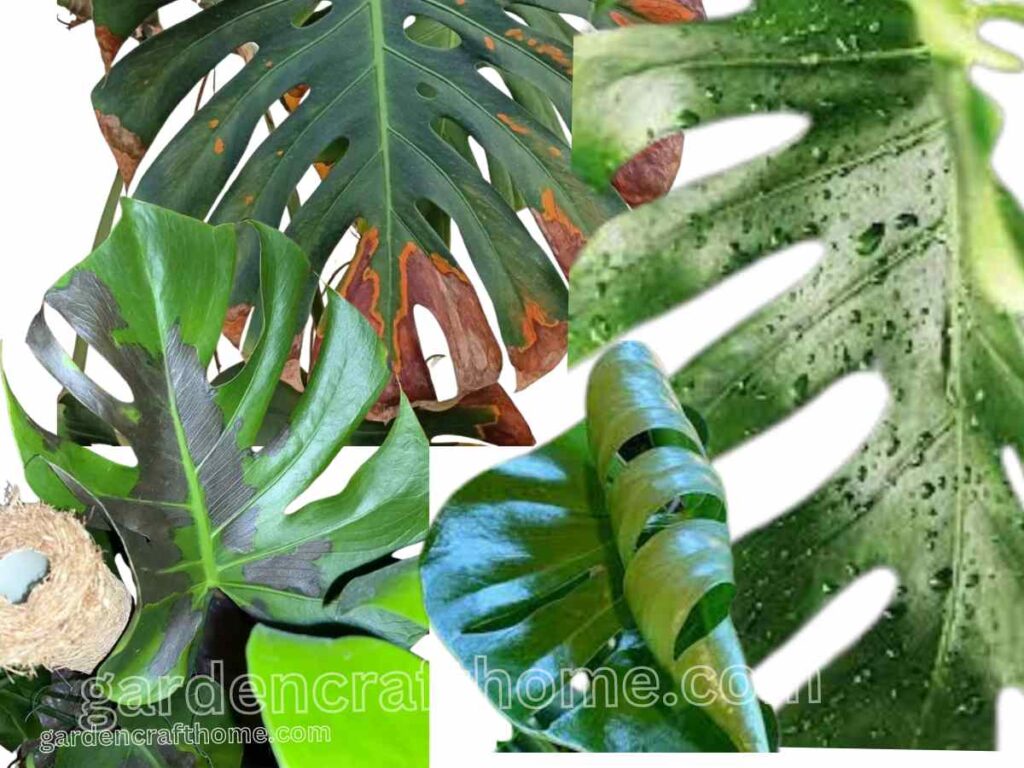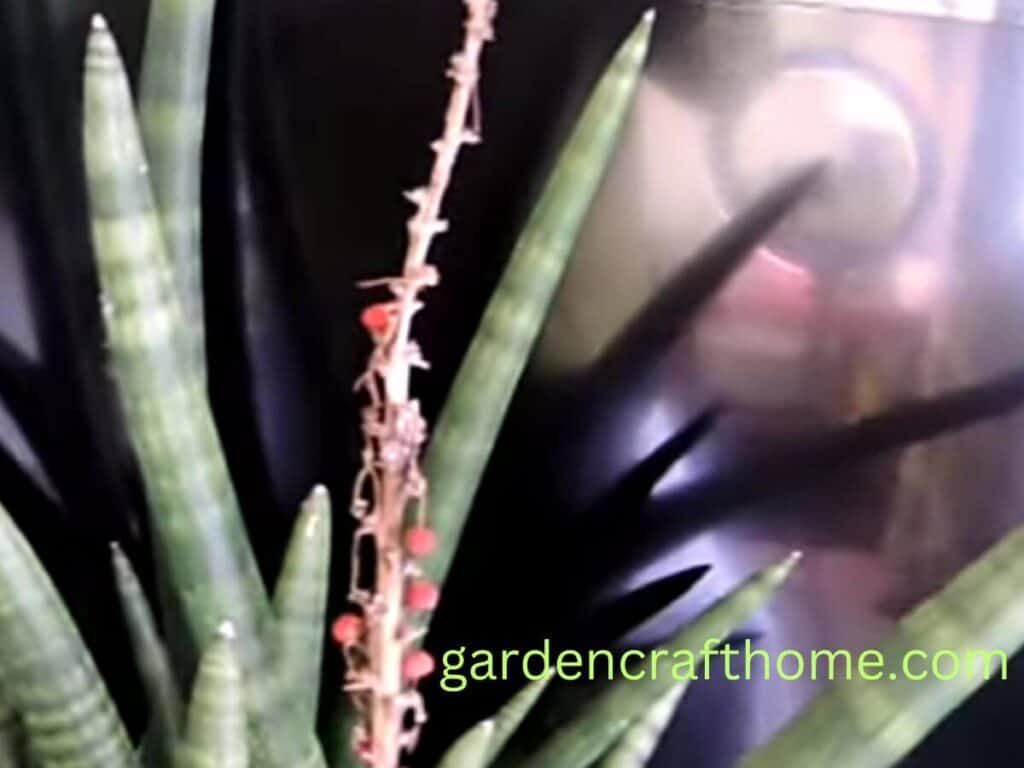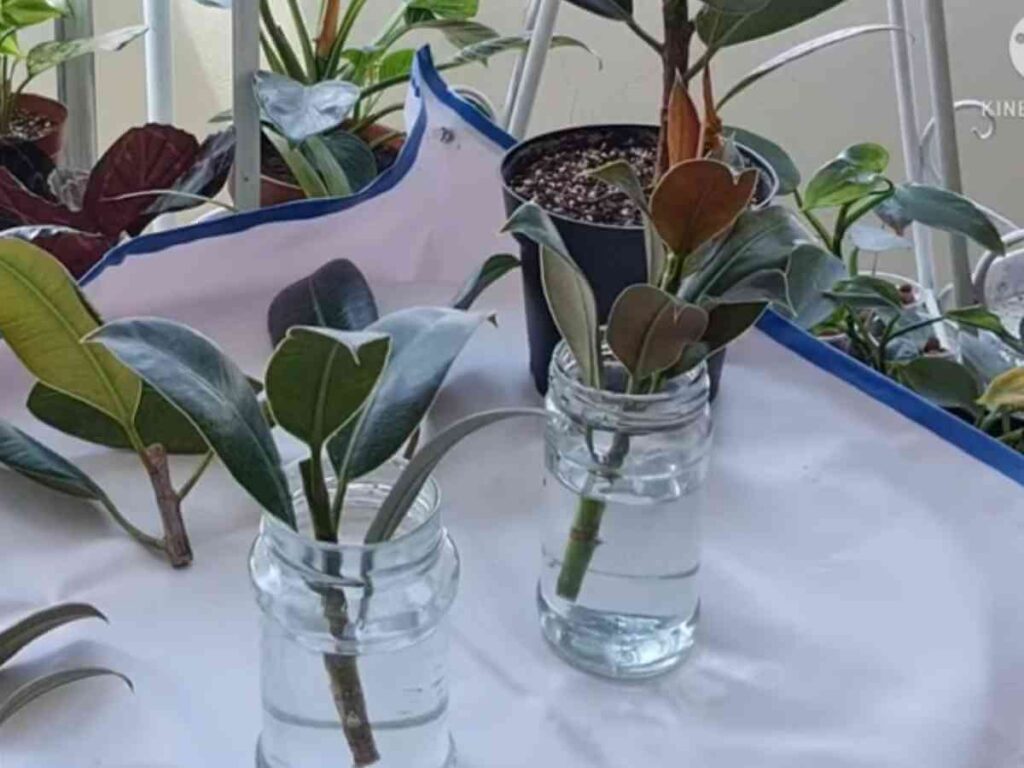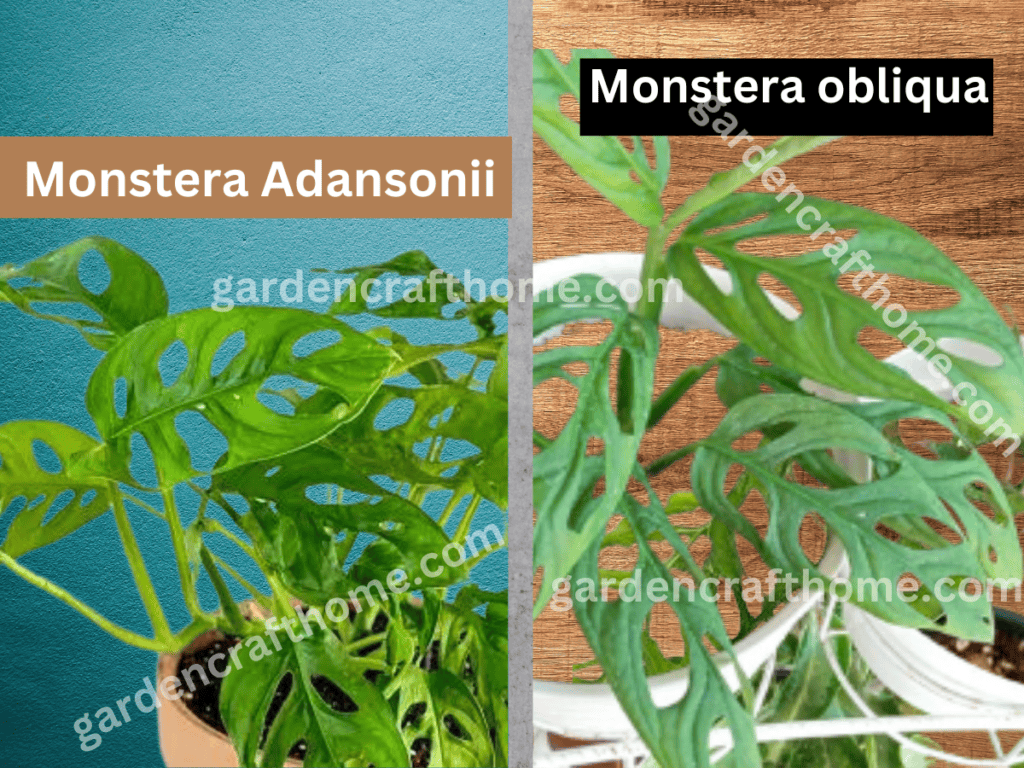Monstera common problems indicate that Monstera is suffering from setting disease.
Did you know that Monstera leaves can talk? Those changes in the leaf are the language of Monstera.
It is fascinating for all monstera owners because these monstera’s common health issues arise occasionally. Stay with me while I explain more.
After digesting this article, you will understand what is wrong with your Monstera from the appearance of its leaves.
Please grab a coffee while we dive into this exciting matter that troubles plant owners.
If you’re also interested in Reading how to propagate monstera, click here.
How To Understand What Problem A Monstera Has With Its Leaves
Depending on the appearance of the leaves, it is possible to understand whether our Monstera deliciosa is fully healthy or has some problems.
A healthy specimen has large, fenestrated leaves of a bright, shiny green Covered with a thick, waxy cuticle that allows water to slide off.
The entire leaf surface has a homogeneous color without any spots or discoloration.
They are smooth and thick, with a single central vein between one fenestration and another.
The appearance of imperfections on Monstera leaves is a symptom of cultural or environmental problems.
I’m not talking about the variegation of a Monstera albo variegata but about the problems of a classic deliciosa or an adansonii.
Dry parts, necrosis, chlorosis Or leaves without holes in an adult plant mean something, And the plant is telling us this in its way.
To help you better understand these signals, I have drawn up a list of 12 “requests for help in Monsterese”, translating them one by one into Italian.
I also invite you to read how to care for Monstera Delicious. Click here to read more. [Link]
What Are The Common Monstera Health Problems?
The common monstera problems do show on their outward. At the same time, some are hidden inside the soil, such as root rot and potential diseases.
In this section, I will list all the potential problems your Monstera is facing.
Before father I do, Let’s start with the most common:
Monstera Yellow leaves
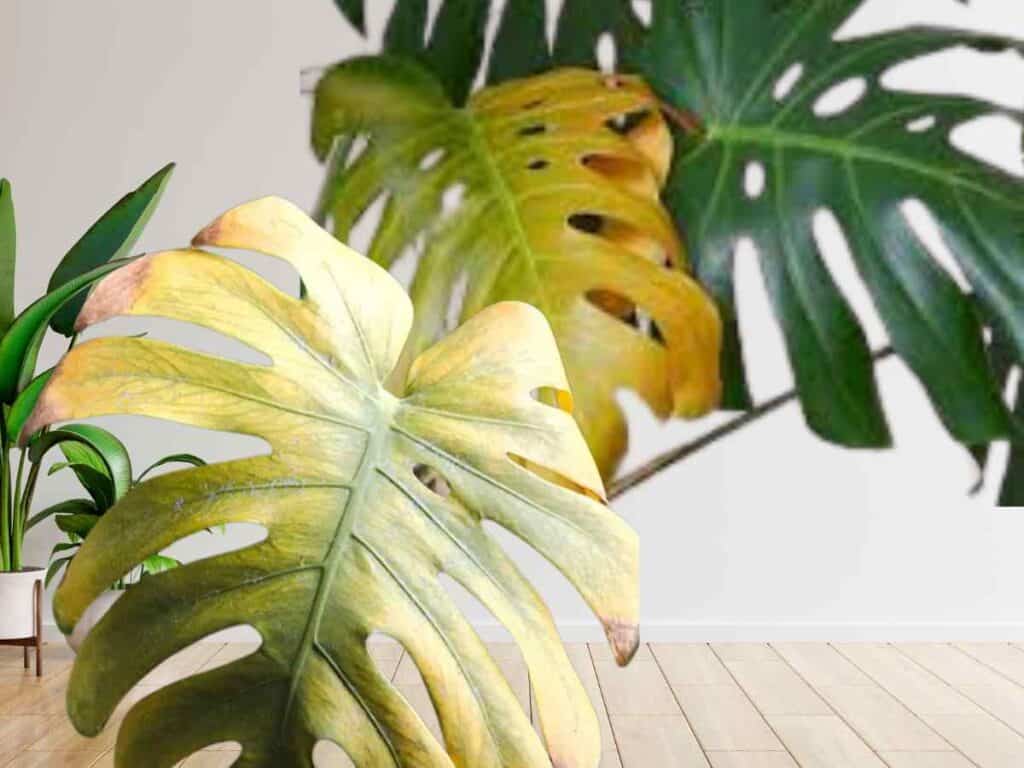
Yellowing leaves is a common problem. When Monstera has yellow leaves, it usually means that we have given it too much water, depriving the roots of oxygen or causing them to rot.
Overwatering is not always the case; however, Leaf yellowing is caused by many other factors, such as:
- Leaf replacement.
- Insufficient water
- Overwatering
- Excess sun
- Nutrient deficiency
- root rot.
- cold damage,
- too much light,
- excessive use of fertilizers,
- limescale accumulation,
- fungal or bacterial diseases
- Etc.
If you want to learn the courses of monstera delicious turning yellow and how to cure them, click here now to read more about it.
All these Common monstera problems mentioned above can suffocate monstera delicious and cause signs like a yellow leaf.
Monstera Leaves With Brown Spots
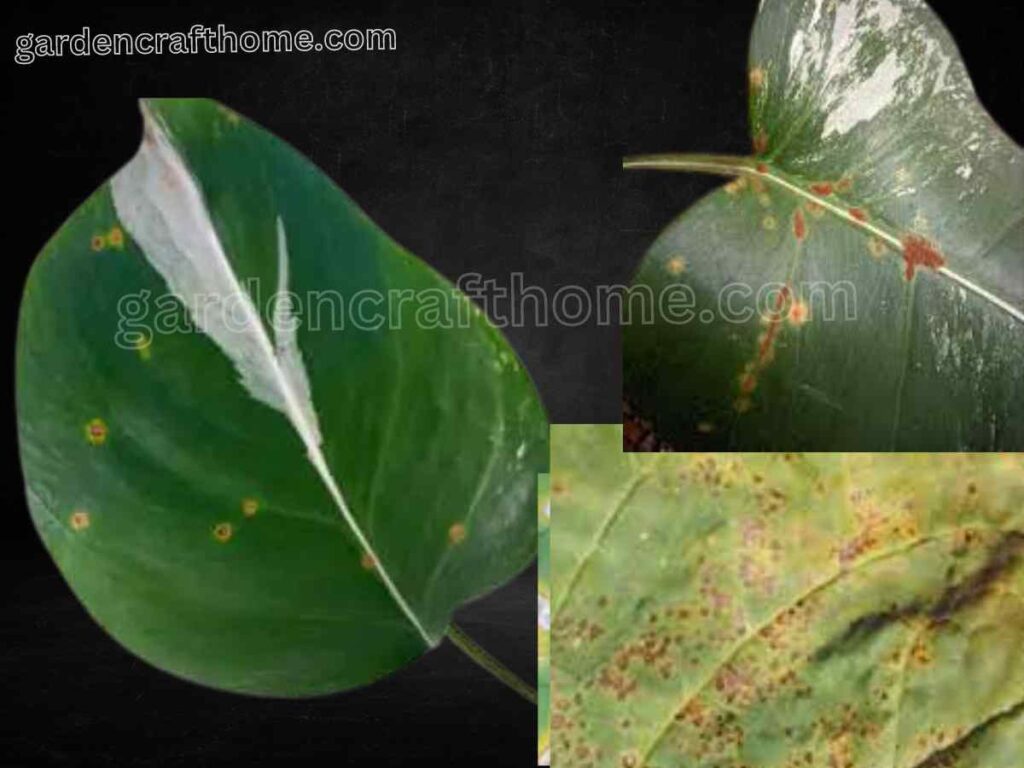
Brown spots are a monstera common health issue that affects this plant. Brown spots on Monstera leaves can mean several things.
It could be burns, fungal diseases, root problems, or water quality issues.
Be careful; we are not talking about black spots here. For those, read the next point.
Sunburnt leaves are pretty easy to recognize. They have a dry appearance and are limited to the brightest leaves.
Around the spot, there will most likely be a discoloration of the leaf, yellowish or whitish.
The color only happens from mid-spring to the first weeks of autumn when the sun’s rays are particularly direct and hot.
Once you protect your plant from full sun, the damage stops and does not worsen.
If fungal infections cause the brown spots, they will usually have a yellow halo around them.
These diseases can start either from the edges or inside the leaf and spread rapidly.
It spreads especially if the climatic conditions are unfavorable, i.e. cold and humid, with little air circulation.
Bacterial infections are even worse than fungal ones. They are more infectious and aggressive.
You can recognize it by their vitreous, slimy appearance and unpleasant smell.
click here to learn how to care for Monstera Adansonii
Monstera Leaves With Brown Edges

Monstera leaves with brown edges are monstera common problems. If the Monstera has brown leaf edges, the main reasons are root rot, salt accumulation in the soil or fungal infections.
In the first case, the plant’s roots rot due to a fungus proliferating when the soil remains wet for too long.
The severely compromised root system can no longer absorb water and nutrients. It manifests with yellowing, brown or black spots on the leaves and dehydration.
The accumulation of salts is due to the fertilizer not used by the plant, which settles in the soil until it becomes toxic.
To learn how to fertilize and choose the right fertilizer for Monstera, I invite you to click here to read how to fertilize a Monstera.
The Monstera dehydrates slowly, starting with the edges of the leaves that begin to dry.
In this case, the leaves may have a shriveled appearance. Depending on the extent of the accumulation.
Lastly, we have fungal diseases. The topic here is vast because there are so many.
Not all of them have dry leaf edges as symptoms. Still, among these, anthracnose usually begins with a peripheral yellowing that dries and turns brown as it progresses towards the inside of the leaf.
Finally, I have a full dedicated article discussing monstera leaf turning brown and how to fix it. If you are interested, click here now to learn more. [Link]
Monstera With Black Leaves
A monstera wheat black leaf is a common monstera disease. A Monstera mainly has black leaves for cold damage and root rot.
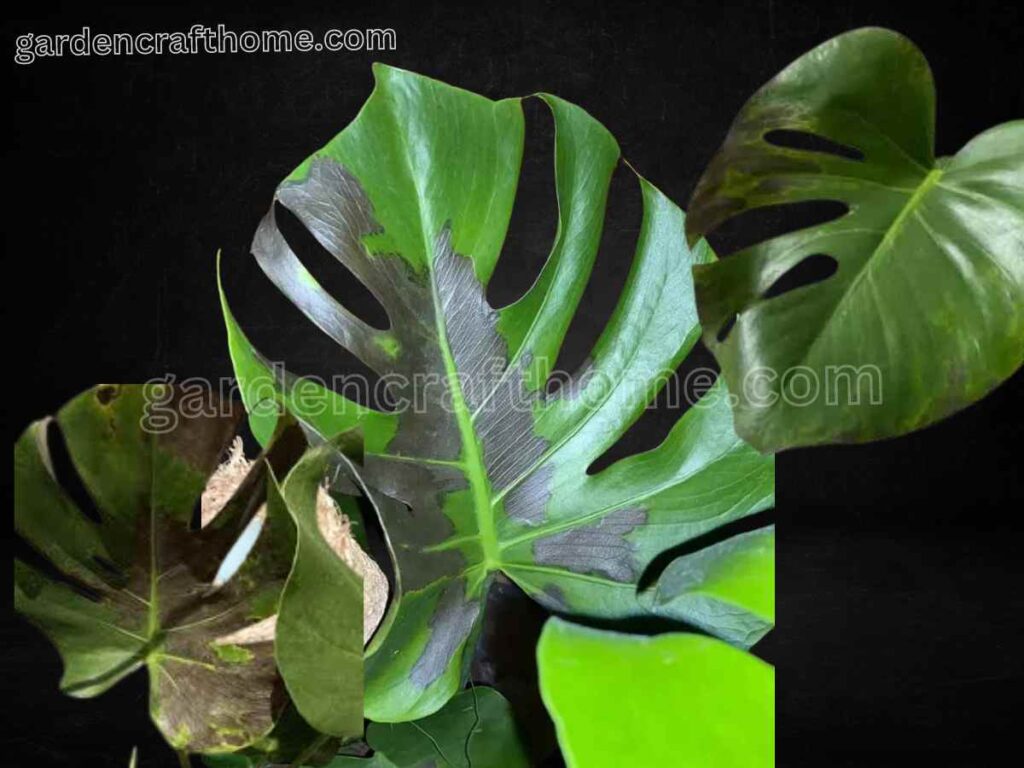
Cold damage is caused by freezing air currents or temperatures below 13-15°C, which cause the plant’s cells to collapse, causing necrosis.
Since they tend to appear a few days later, diagnosing them is not always easy.
More often than not, the problem occurs during transportation or while in the store.
You buy a healthy Monstera, and a few days later, the leaves turn black.
Or forget about the flowering plant in autumn and find it wholly ruined due to a freezing night.
As mentioned before, root rot causes the roots’ death and, consequently, a series of problems relating to water absorption and nutrients.
Furthermore, the lesions caused can open the door to other even more severe fungal or bacterial infections.
Repot your monstera immediately from the pot and check the roots if you’re worried about root rot.
I have already written a whole article concerning repotting a monstera plant click here to read now. [Link]
Monstera Leaves With Dry End
Monstera leave with dry tips is a monstera common health issue, When a Monstera has dry leaf tips, nine times out of ten, it is because it is not getting enough watered h or the ambient humidity is too low.
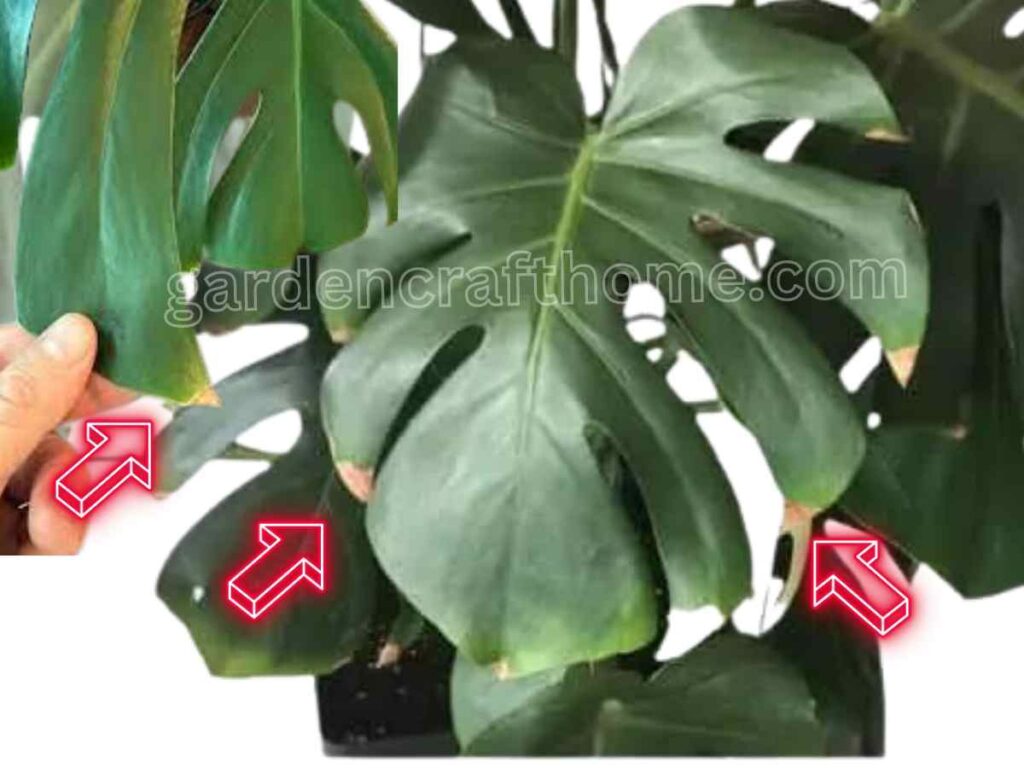
If the problem is watering, the plant will look limp and shrivelled, and the soil will be dry and Very easy to recognize.
If watering is the case I invite you to click here so you will learn how to water Monstera properly. [Link]
Regarding too low humidity, however, even if the Monstera tolerates climates with 40-50% humidity well (typical in the home) when conditions become extreme, it begins to suffer.
Dehydration causes the ends of the leaves to dry off. The plant disperses water faster than it can integrate through the lymphatic system.
I’m talking about very dry climates, which can occur during the winter with heating, for example—or hot, dry periods during the summer.
Humidity and temperature go hand in hand.
A Monstera tolerates a dry environment better if temperatures are mild.
However, it may suffer when very hot, even if the humidity level is slightly higher.
Are you interested click here to read how to build a wooden vertical planter.
Monstera With Burnt Leaves

Burnt leaves are common monstera diseases; as much as the Monstera loves light, even direct sunlight, burns will likely appear on the leaves if we leave it in the full summer sun.
Burnt leaves are due to intense light and heat, which the plant cannot dissipate through transpiration.
The problem is rather easy to recognize because it only affects leaves exposed to the sun, and exclusively when the Monstera receives direct light during the hot hours of the day, from late spring to early autumn.
Move the plant to a more sheltered location during this time of year. Or block the light with an opaque curtain.
Depending on the extent of the damage, Monstera burned leaves can be cut at the base or kept.
If it is a small burn, there are no problems, and if the burn is extensive, it is best to remove the leaves to prevent the wounds from attracting pathogens.
Monstera With Soft Leaves
The soft leaf that appears in Monstera is one of Monstera’s common health issues. The limp leaves are a sign that the Monstera is dehydrated.
The first thing that comes to mind is that it received little water, but this is not always true.
The causes of dehydration are:
- Insufficient watering,
- Excessive heat,
- Vase too small,
- Root damage.
The first tip is simple: water the Monstera more often, leaving the soil to dry properly between waterings.
When it is very hot, the plant may transpire more water than it can absorb from the soil.
We are talking about extreme circumstances, above 35°C, but it can happen during the summer in Italy.
In this case, you must move the Monstera to a shady and humid place to slow down its metabolism and help it hydrate.
Suppose the pot is very small (concerning the leaves). In that case, the plant must be watered often, particularly during the hot months.
A few hours late in watering, you could find your Monstera with limp leaves falling on itself.
Consider repotting the Monstera if this is the case. Not only will you be able to reduce watering, but the plant’s growth will explode.
Click here now to learn how to report a monstera.
Finally we find problems with the root system. Whether it is root rot or dead roots due to dehydration, they can no longer absorb enough water to keep the leaves turgid.
Monstera With Crumpled Leaves

Folding leaves in Monstera is monstera common problem. The main reason a plant’s leaves are curled, faded, or wilted is a watering error.
The Monstera is dehydrated, or watering is delayed too often. Over time, this causes the leaf to wilt.
There are other reasons; in most cases, they have to do with dehydration. As:
- Humidity Too Low
- Accumulation Of Salts In The Soil
- Excessively Hot Temperatures
- Root Rot
In addition to these, Monstera leaves can also wrinkle following parasitic infestations. In particular, thrips, scale insects, fungus gnat larvae or nematodes.
I have already written an article about Monstera folding or crumpling leaves. If you are interested, click here to learn more about it. [Link]
Monstera Leaves Without Holes.
Monstera are known as leaves with holes, but when you do not see those holes, it is a common problem.
Monstera leaves do not have holes until the plant reaches 9-12 months of age and a height of approximately 60-70cm. At this point, the first cut leaf is obtained under the right conditions.
Normally, the monstera plants we find on the market are already mature, so much so that the leaves are already fenestrated.
From the appearance of the first fenestration, the plant produces only cut or fenestrated leaves.
We aren’t giving it enough light if this isn’t the case.
Light is a fundamental factor in this regard. Is the plant in the shade? Rest assured that the leaves will grow without holes.
Place the Monstera in a bright place, even with a few hours of direct light in the morning or evening, and it will make leaves that are increasingly larger and full of fenestrations.
If you don’t have good exposure you can compensate for the deficiency with even economical cultivation LEDs.
A monstera leaf born without holes cannot make them later. It is now formed and will not change morphology.
But if the plant has already done so in the past, it has all the requirements to do so in the future, Starting from the next one.
Monstera With Wet Leaves
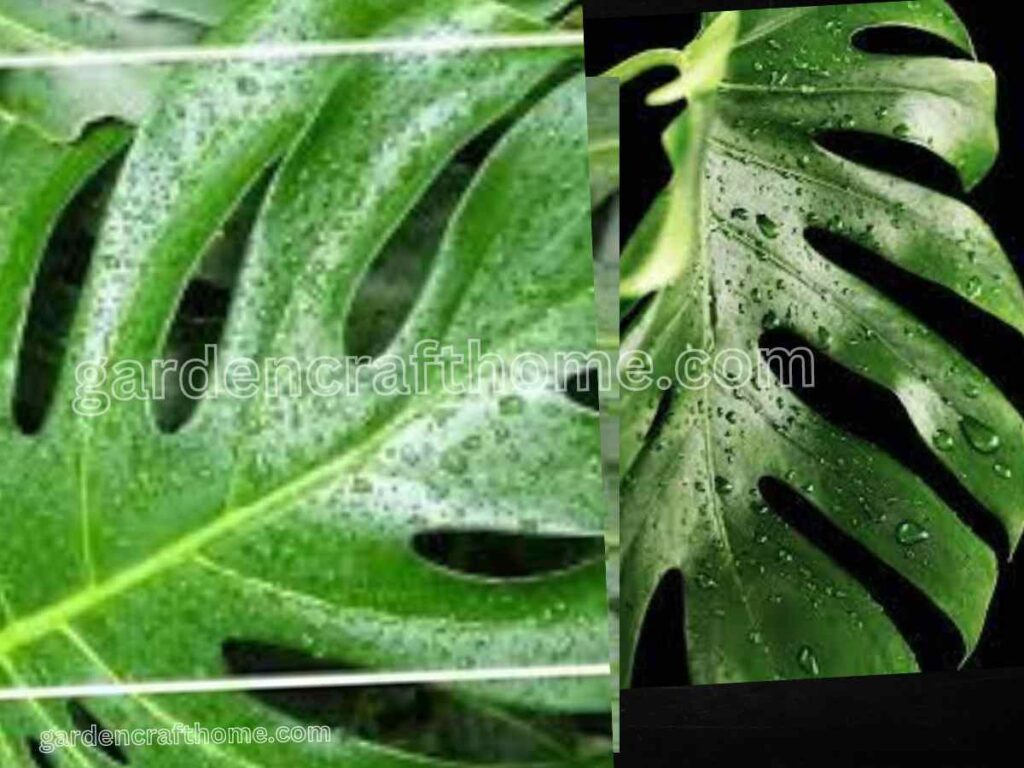
Monstera with sweating leave is a common monstera disease when they suffer stress or nutrients.
The drops of water that are created on the leaves are due to a very common phenomenon called guttation. Monstera exudes sap from its leaves.
The guttation happens during the night hours when the soil is very wet.
Now I’ll explain better: During the day, the stomata and pores of the leaves are open and allow water to evaporate. The plant does this to be able to carry out photosynthesis.
However, the stomata close during the night so as not to unnecessarily waste water.
If the soil is very wet, perhaps because we watered the day before, the roots absorb more water than the plant needs.
It causes an increase in pressure inside the xylem, the lymphatic channel that transports raw sap (water + mineral salts) from the roots to the leaves.
Due to this pressure, excess water exudes from the stomata, creating droplets on the leaves.
Guttation does not cause any harm to the Monstera, and it is not a phenomenon to be afraid of.
Just make sure it’s not due to watering too frequently or the soil staying wet for too long.
To know the causes and cure of Monstera wet leaf, click here now.[Link]
Monstera With Yellow Spots
The yellow spot on Monstera leaf is one of the monstera common problems Monstera owners face.
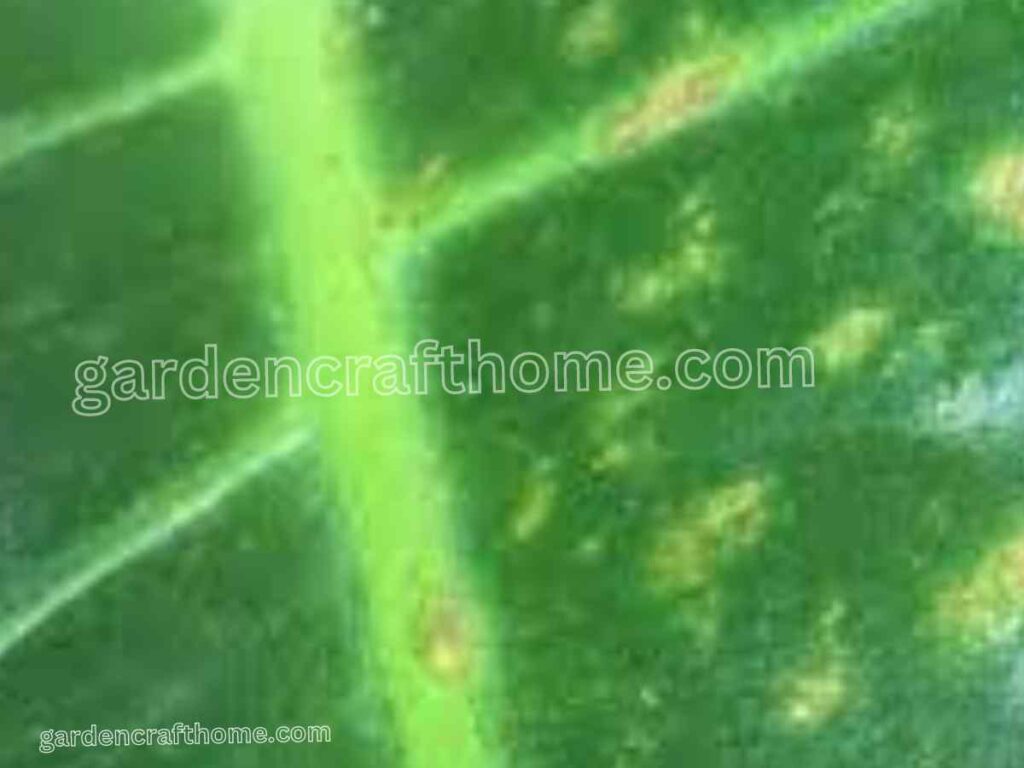
The appearance of yellow spots inside Monstera leaves nine times out of ten is due to fungal or bacterial infections.
These pathogens proliferate in humid environments without air circulation or when water stagnates on the leaves for too long.
Fungi cause different yellow spots or dots, while bacterial infections cause watery-looking and often smelly spots.
We must not underestimate them, and it is important to act promptly.
First, isolate the Monstera to prevent it from transmitting the disease to other plants.
Then, you have to cut the stained part of the leaf using sterilized scissors (with bleach, alcohol or flame). The cut must be made where the tissue is still green and healthy.
If the infection has spread to a large part of the leaf, removing the entire leaf at the base is best.
To know how to trim monstera effectively without shock, click here now.
Keep the plant under observation in a dry and well-ventilated environment.
If the infection resumes, treatment with a systemic fungicide or specific antibiotic will be best, depending on whether it is a fungal or bacterial infection.
Pest
Monstera’s common problem is pests; although they are resistant to many pests, they can be affected by insects such as thrips, mites, and mealybugs.
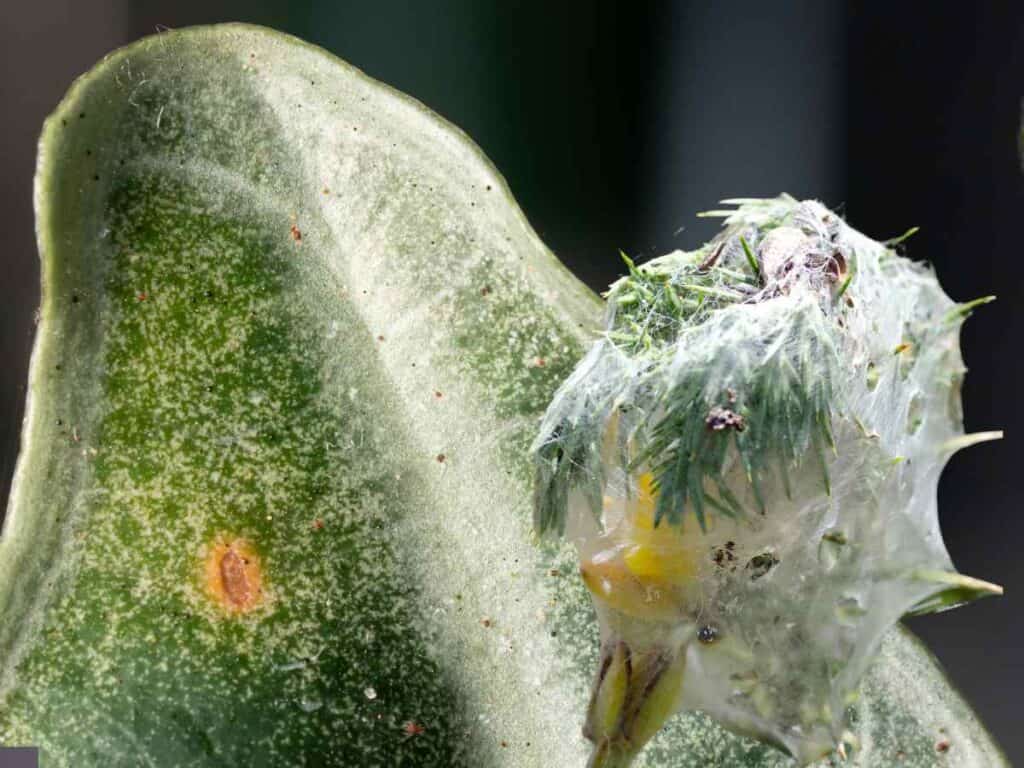
To identify and treat these common problems, remove mealybugs manually with a cotton ball soaked in isopropyl alcohol or insecticidal soap.
Red spiders suck plant sap and can spin fine webs, causing yellowing of leaves and small yellow or brown spots.
To remove them, spray the plant with water, wipe the leaves with 70% isopropyl alcohol, or apply neem oil.
Thrips suck moisture from plants, leaving them dry and brown.
To treat them, remove affected leaves, wash the plant with a garden hose, or apply insecticidal soap and neem oil.
To prevent future infestations, buy plants from trusted nurseries, quarantine new plants for at least two weeks, and maintain plants in good condition with enough water and humidity.
Check for pests every time you water them, and occasionally apply preventative treatments with neem oil.
Conclusions For Monstera Common Problem
I hope this article on Monstera leaf problems has helped you diagnose your plant’s symptoms.
I realize the topic is broad and could not include all the necessary information and care here.
So I wrote them to go in-depth concerning any causes; click on the Link I provided for each section to learn more.
Remember to avoid direct sunlight overwatering, use the right fertilizer, don’t over-fertilize and use the right soil.
Read the following blog post to help you understand your monstera plant better. [Link]

